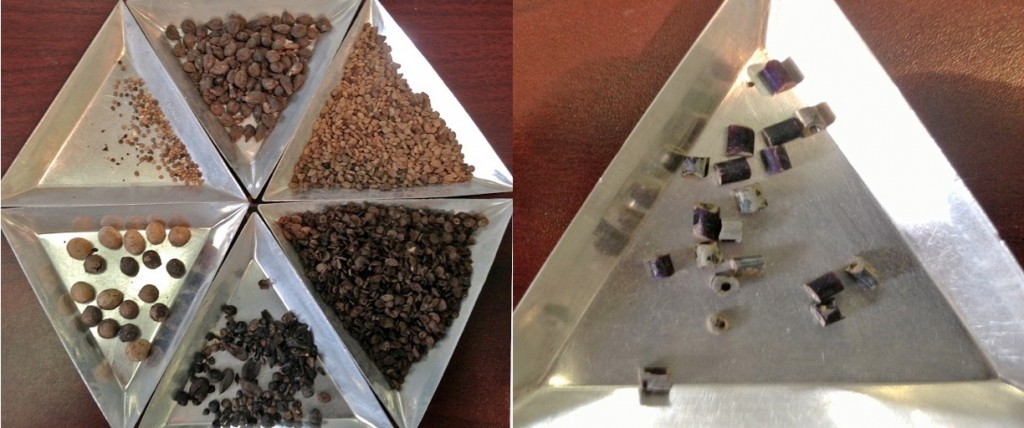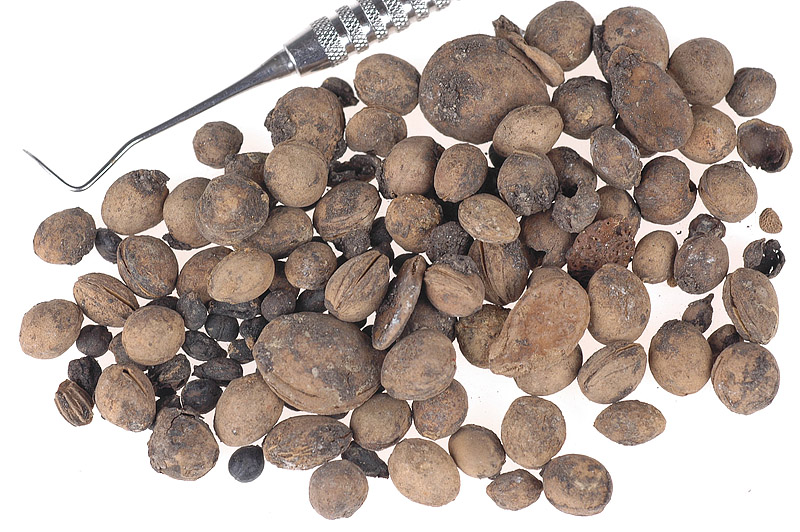June 2016 – Artifact of the Month
To Artifact of the Month Index
To PAF Home
Archaeobotanical Wonders:
Plant Remains in Archaeological Site Soils
Pits and Seeds -including Cherry, Grape, Apricot, Squash/Melon, and Strawberry – from excavated soil collected at the National Constitution Center archaeological site in Independence National Historical Park (INHP). This plant evidence was recovered during archaeological laboratory work called Flotation Heavy Fraction. Photo provided by INHP: Lot 30L, Feature 68, N399 E215, Strat. VI, Excavation Date 12/29/2000, Depth 19.27-19.02 ft amsl, FS No. 1902.
Thousands and thousands of pits and seeds were found a decade ago during excavations at the site of the National Constitution Center (NCC) in Independence National Historical Park in Philadelphia, Pennsylvania. The three city blocks making up today’s Independence Mall were once in the heart of the colonial- and federal-era Philadelphia. The abundant plant remains were recovered alongside close to a million other metal, ceramic, bone, and glass artifacts. Such pits, seeds, and even pollen provide rich insights into the life of the city’s early inhabitants. This part of archaeological research is called archaeobotany (archaeology + botany, or the study of the past + the science and study of plant life).
Archaeologists start their search for plant evidence when excavating a site. As they dig down through the layers of history they save small amounts of soil from each period of site occupation. These soil samples are then taken to an archaeological lab for processing along with any recovered ceramic, metal, and bone artifacts. Soil sample processing involves a procedure called archaeological flotation. The procedure involves using water to recover artifacts that are too tiny for an archaeologist to see and gather while at the site.
Once at the lab, a dried soil sample is placed on a fine (small) mesh screen. Water is then gently bubbled up through the soil which causes any seeds, charcoal, and other light materials to float. These lighter materials (called light fraction) are collected for the next step of artifact processing which involves the identification of the plant species or variety followed by an analysis to determine the plant’s ‘use’ or cultural/historical ‘meaning’. Heavier plant materials (heavy fraction) do not float in the water stream and remain behind laying in the screen. These too are collected for the next stages of identification and analysis. A brief discussion of laboratory plant processing is described here by archaeologist Brian Seidel who conducted flotation for the Gunner’s Run archaeology site in the Northern Liberties neighborhood in Philadelphia.

Flotation results for the Gunnar’s Run Site in Philadelphia, excavated for a Pennsylvania Department of Transportation highway project (Photo: Brian Seidel of URS Corporation, 2013)
Once all the plant matter is identified to species or variety, the archaeologist records the information in an inventory, or list. That information is then used alongside other artifact evidence to help interpret the history of human activity at the site. The inventory shown below serves as an example of this type of analysis.
Chart in APPENDIX D: MORE THAN JUST A MEAL: PALEOETHNOBOTANY OF THE INDEPENDENCE VISITOR CENTER, BLOCK 2, INDEPENDENCE MALL, PHILADELPHIA, PENNSYLVANIA by Leslie E. Raymer (2002), in HUDSON’S SQUARE—A PLACE THROUGH TIME, ARCHEOLOGICAL DATA RECOVERY ON BLOCK 2 OF INDEPENDENCE MALL, by Rebecca Yamin. Submitted to Day & Zimmermann Infrastructure, Inc., 2002, revised 2007.
This (above) inventory records some of the plant evidence collected from the second block of Independence Mall during archaeological excavations conducted in 1999 (Yamin 2007, Appendix D:2). During that excavation, soil samples were taken from four different privies (or outhouses) whose contents dated to the eighteenth and nineteenth centuries. Along with the recovered artifacts, the plant evidence in these soil samples provided insight into an early neighborhood once home to tradesmen, artisans, small shopkeepers, and some well-to-do occupants: physicians, an ironmonger, a cooper, a tailor, a notary, and an accountant (Yamin 2002:2). The archaeobotanical research at this site examined the nature of plant use in the neighborhood and the incidence of plant changes over time. It also considered the differences in diet and other plant use between the affluent and laboring residents. Home gardening in the area, and the availability and use of wild and or ornamental plants, was likewise assessed in an effort to better understand what the local environment was like. As part of Philadelphia archaeology, archaeobotany research is providing important evidence about the environmental conditions of the colonial city and the extent to which this environment was exploited and modified overtime.
__________________
Read more…
APPENDIX D: MORE THAN JUST A MEAL: PALEOETHNOBOTANY OF THE INDEPENDENCE VISITOR CENTER, BLOCK 2, INDEPENDENCE MALL, PHILADELPHIA, PENNSYLVANIA by Leslie E. Raymer (2002), in HUDSON’S SQUARE—A PLACE THROUGH TIME, ARCHEOLOGICAL DATA RECOVERY ON BLOCK 2 OF INDEPENDENCE MALL, by Rebecca Yamin. Submitted to Day & Zimmermann Infrastructure, Inc., 2002, revised 2007.
A Day of Archaeology – Flotation, by Bill Seidel.
————————–
This Artifact of the Month write up was contributed by Patrice L. Jeppson.
by admin

